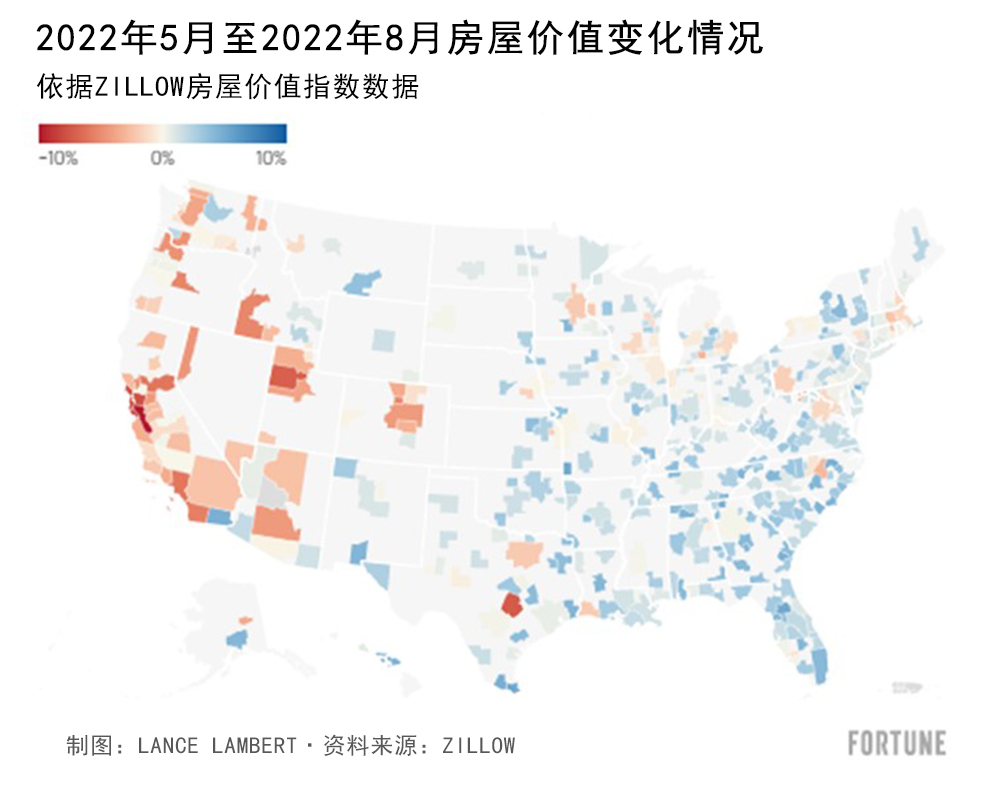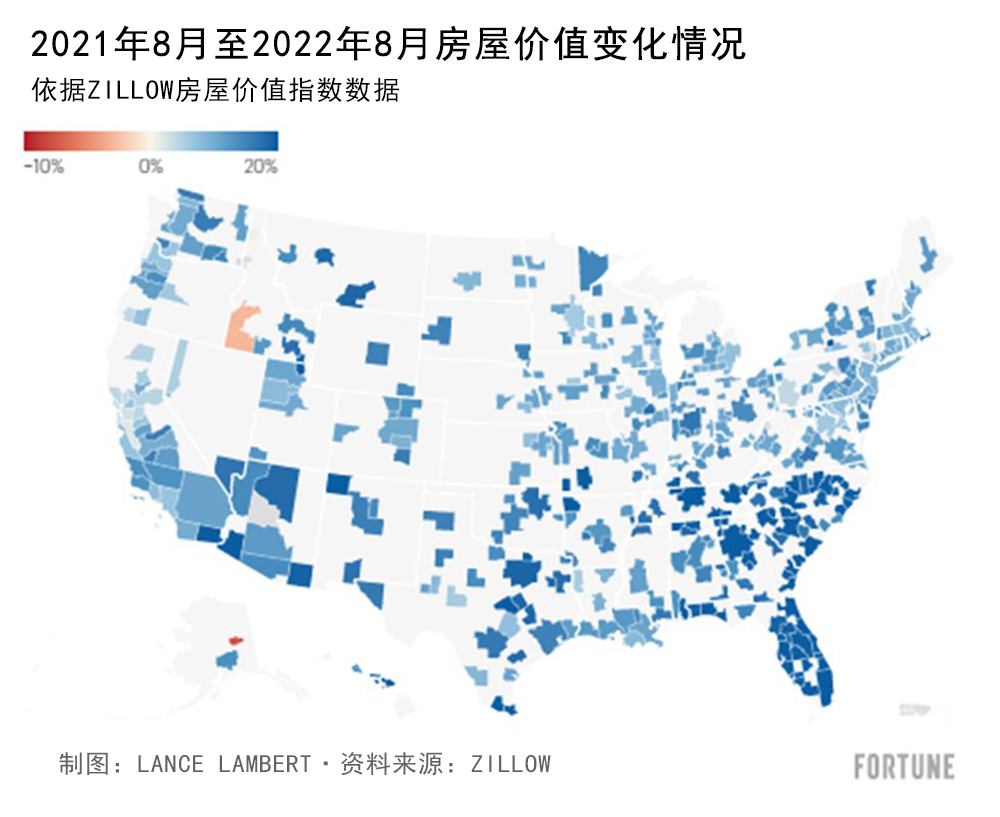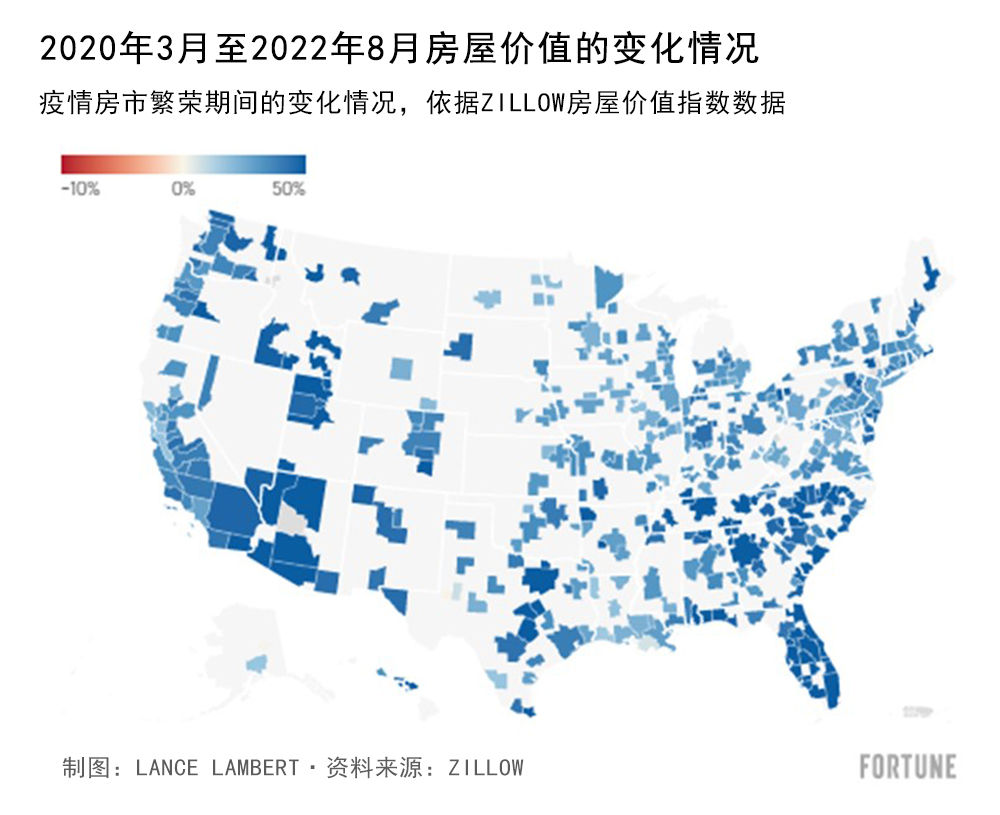用“承压”一词来形容当前的美国房市可能是再贴切不过了。创纪录的房价增幅——新冠疫情期间增长了43%,外加6%的抵押贷款利率,让数百万潜在购房者望而却步。受到这两大因素的影响,新购房者的债务收入比达到了房产泡沫时期的峰值水平。
房价承受力问题已经将美国房市推入了下行通道。房屋销量持续下滑,房屋建筑商不断取消项目,而房地产公司亦祭出了裁员大旗。
可以肯定的是,美联储(Federal Reserve)通胀应对举措导致的房产市场持续下滑将带来房产交易的大幅下探,但我们并不确定房价是否也会因此而受到波及。
为了更好地理解房价到底出现了什么问题,《财富》杂志查看了Zillow房屋价值指数(Zillow Home Value Index)给出的月度房屋价值,共涉及美国896个地区的房市数据。
让我们来看看Zillow的数据。

今年5月,穆迪分析(Moody's Analytics)的首席经济师马克·赞迪做出了一个大胆的预测:房市很快将进入房价修正期。到目前为止,他的预测是正确的。在Zillow跟踪的896个重点区域房市中,117个市场的房屋价值在2022年5月至8月期间出现了下滑。
受房价修正影响最严重的莫过于以下两种房市。
第一种是充满泡沫的市场,例如奥斯汀(下滑7.4%)、博伊西(下滑5.3%)、丹佛(下滑4.3%)、拉斯维加斯(下滑2.3%)和菲尼克斯(下滑4.4%)。上述市场的一些买家来自于圣何塞和西雅图这类城市,个个财大气粗。在他们的推动下,这些地区的房价已经远超历史上当地居民收入能够承受的范围。一旦抵押贷款利率有所升高,房市热度就会褪去,甚至连富有的外市买家也会打退堂鼓。正因为如此,像博伊西和奥斯汀这样的市场如今已经走到了房市崩盘全面爆发的边缘。
然而,最大的房价跌幅并不会出现在泡沫市场。实际上,房价的最大跌幅可能会出现在像旧金山(下滑7.8%)和圣何塞(下滑10.6%)这类高成本科技中心,因为这些市场会遭受双重噩梦的打击。这里的高端房产市场对利率更加敏感,而且其所处的科技领域亦是如此。

毫无疑问的是,不断上升的抵押贷款利率给房价带来了下行压力。然而到目前为止,持续的房价修正在削弱疫情房市繁荣(Pandemic Housing Boom)带来的增幅方面没有发挥多大的作用。
事实上,仅有博伊西和费尔班克斯在2021年8月至2022年8月期间出现了房屋价值同比下滑的现象。

如果人们进一步缩小时间跨度,那么博伊西这类市场2022年的房价下跌看起来就会显得更加微不足道,至少与疫情房市热期间的增幅相比是这样。即便考虑博伊西今年夏季5.3%的房价跌幅,该地区房价自2020年3月以来依然上涨了48.6%。
然而,我们可能依然会看到,疫情房市热带来的增幅将不断缩水。
像穆迪分析、Zonda、约翰·伯恩斯房地产咨询公司(John Burns Real Estate Consulting)、TD Bank和Zelman & Associates这类研究公司预计,房价修正运动将继续在全美蔓延。需要特别注意的是,美国阳光地带泡沫市场的风险依然最高。
约翰·伯恩斯房地产咨询公司的研究负责人小里克·帕拉西奥斯告诉《财富》杂志:“我们认为,抵押贷款利率高位运行的时间越长,房市就将持续感受到修正的压力,并启动这类重置模式。当前,已成必然的承受力重置机制会拿房价开刀。因此,我们预测全美很多市场的房价将出现双位数跌幅。”(财富中文网)
译者:冯丰
审校:夏林
用“承压”一词来形容当前的美国房市可能是再贴切不过了。创纪录的房价增幅——新冠疫情期间增长了43%,外加6%的抵押贷款利率,让数百万潜在购房者望而却步。受到这两大因素的影响,新购房者的债务收入比达到了房产泡沫时期的峰值水平。
房价承受力问题已经将美国房市推入了下行通道。房屋销量持续下滑,房屋建筑商不断取消项目,而房地产公司亦祭出了裁员大旗。
可以肯定的是,美联储(Federal Reserve)通胀应对举措导致的房产市场持续下滑将带来房产交易的大幅下探,但我们并不确定房价是否也会因此而受到波及。
为了更好地理解房价到底出现了什么问题,《财富》杂志查看了Zillow房屋价值指数(Zillow Home Value Index)给出的月度房屋价值,共涉及美国896个地区的房市数据。
让我们来看看Zillow的数据。
今年5月,穆迪分析(Moody's Analytics)的首席经济师马克·赞迪做出了一个大胆的预测:房市很快将进入房价修正期。到目前为止,他的预测是正确的。在Zillow跟踪的896个重点区域房市中,117个市场的房屋价值在2022年5月至8月期间出现了下滑。
受房价修正影响最严重的莫过于以下两种房市。
第一种是充满泡沫的市场,例如奥斯汀(下滑7.4%)、博伊西(下滑5.3%)、丹佛(下滑4.3%)、拉斯维加斯(下滑2.3%)和菲尼克斯(下滑4.4%)。上述市场的一些买家来自于圣何塞和西雅图这类城市,个个财大气粗。在他们的推动下,这些地区的房价已经远超历史上当地居民收入能够承受的范围。一旦抵押贷款利率有所升高,房市热度就会褪去,甚至连富有的外市买家也会打退堂鼓。正因为如此,像博伊西和奥斯汀这样的市场如今已经走到了房市崩盘全面爆发的边缘。
然而,最大的房价跌幅并不会出现在泡沫市场。实际上,房价的最大跌幅可能会出现在像旧金山(下滑7.8%)和圣何塞(下滑10.6%)这类高成本科技中心,因为这些市场会遭受双重噩梦的打击。这里的高端房产市场对利率更加敏感,而且其所处的科技领域亦是如此。
毫无疑问的是,不断上升的抵押贷款利率给房价带来了下行压力。然而到目前为止,持续的房价修正在削弱疫情房市繁荣(Pandemic Housing Boom)带来的增幅方面没有发挥多大的作用。
事实上,仅有博伊西和费尔班克斯在2021年8月至2022年8月期间出现了房屋价值同比下滑的现象。
如果人们进一步缩小时间跨度,那么博伊西这类市场2022年的房价下跌看起来就会显得更加微不足道,至少与疫情房市热期间的增幅相比是这样。即便考虑博伊西今年夏季5.3%的房价跌幅,该地区房价自2020年3月以来依然上涨了48.6%。
然而,我们可能依然会看到,疫情房市热带来的增幅将不断缩水。
像穆迪分析、Zonda、约翰·伯恩斯房地产咨询公司(John Burns Real Estate Consulting)、TD Bank和Zelman & Associates这类研究公司预计,房价修正运动将继续在全美蔓延。需要特别注意的是,美国阳光地带泡沫市场的风险依然最高。
约翰·伯恩斯房地产咨询公司的研究负责人小里克·帕拉西奥斯告诉《财富》杂志:“我们认为,抵押贷款利率高位运行的时间越长,房市就将持续感受到修正的压力,并启动这类重置模式。当前,已成必然的承受力重置机制会拿房价开刀。因此,我们预测全美很多市场的房价将出现双位数跌幅。”(财富中文网)
译者:冯丰
审校:夏林
Pressurized. That might be the best word to describe the current U.S. housing market. Record home price appreciation—up 43% during the pandemic—coupled with 6% mortgage rates is sidelining millions of potential homebuyers. The combination puts debt-to-income ratios for new buyers on par with levels hit during the peak of the housing bubble.
That affordability crunch has already pushed the U.S. housing market into a housing downturn. Home sales are tanking. Homebuilders are calling off projects. And real estate firms are turning to layoffs.
While it’s clear this ongoing housing downturn—spurred by the Fed’s inflation fight—will see a sharp decline in housing activity, it’s less clear how it will impact home prices.
To better understand what’s going on with home prices, Fortune looked at monthly home values as measured by the Zillow Home Value Index (ZHVI). In total, we looked at data for 896 regional U.S. housing markets.
Let’s take a look at the Zillow data.
Back in May, Moody's Analytics chief economist Mark Zandi made a bold proclamation: The housing market would soon enter a home price correction. So far, he looks right. Among the 896 major regional housing markets tracked by Zillow, 117 markets saw home values fall between May 2022 and August 2022.
The housing markets getting hit the hardest by the home price correction fall into one of two groups.
The first group includes bubbly markets like Austin (down 7.4%), Boise (down 5.3%), Denver (down 4.3%), Las Vegas (down 2.3%), and Phoenix (down 4.4%). Those markets saw deep-pocketed buyers from cities like San Jose and Seattle drive up prices far beyond what local incomes would historically support. Those booms fizzled out once spiking mortgage rates sidelined even the affluent out-of-town buyers. That's why markets like Boise and Austin are now teetering on full-blown housing busts.
But the biggest price declines aren't in bubbly markets. Indeed, the biggest drops in home values can be found in high-cost tech hubs like San Francisco (down 7.8%) and San Jose (down 10.6%). Those markets got hit by a double whammy. Not only are their high-end real estate markets more rate-sensitive, but so are their tech sectors.
There's no doubt about it: Spiking mortgage rates are putting downward pressure on home prices. However, the ongoing home price correction has done little so far to chip away at the Pandemic Housing Boom gains.
In fact, just Boise and Fairbanks posted year-over-year home value declines between August 2021 and August 2022.
If one zooms out even further, the 2022 price drops in markets like Boise look even smaller—at least relative to the gains we've seen during the Pandemic Housing Boom. After the 5.3% price drop in Boise this summer is accounted for, home values in the market are still up 48.6% since March 2020.
But we could still see more Pandemic Housing Boom gains erased.
Research firms like Moody's Analytics, Zonda, John Burns Real Estate Consulting, TD Bank, and Zelman & Associates expect the home price correction to continue spreading across the country. Bubbly markets across the Sunbelt, in particular, remain at the highest risk.
“The longer that [mortgage] rates stay elevated, our view is that housing is going to continue to feel it and have this reset mode. And the affordability resetting mechanism right now that has to happen is on [home] prices. And so there are a lot of markets across the country where we’re forecasting that home prices are going to fall double digits,” Rick Palacios Jr., head of research at John Burns Real Estate Consulting, tells Fortune.






